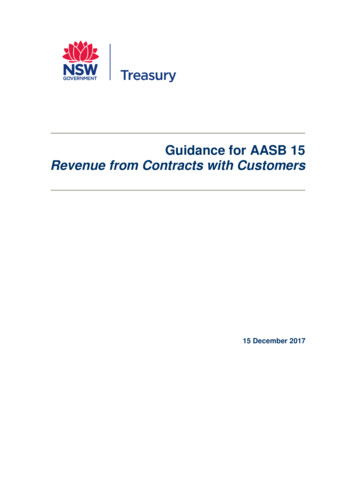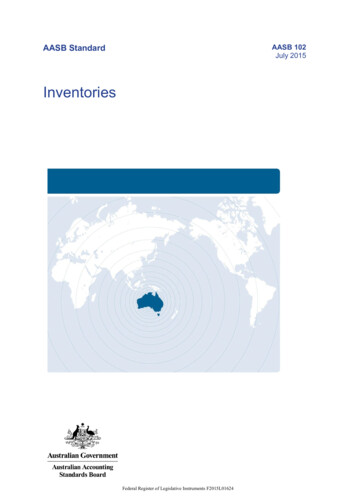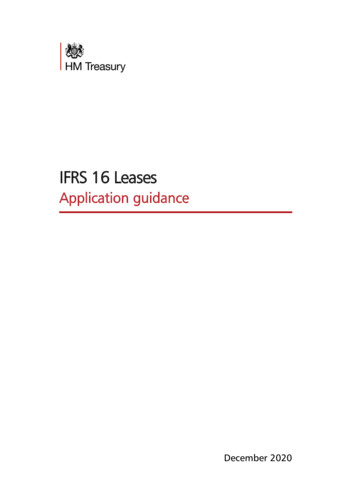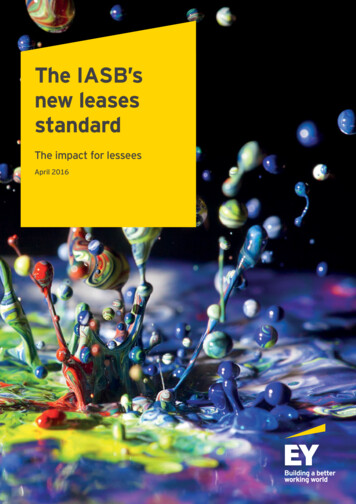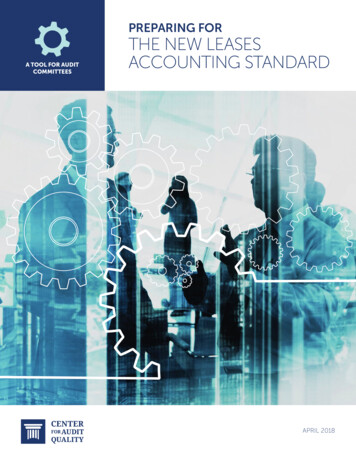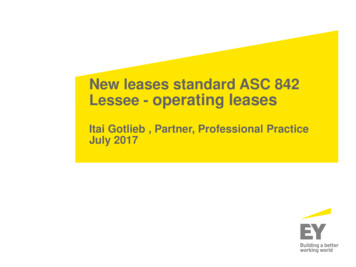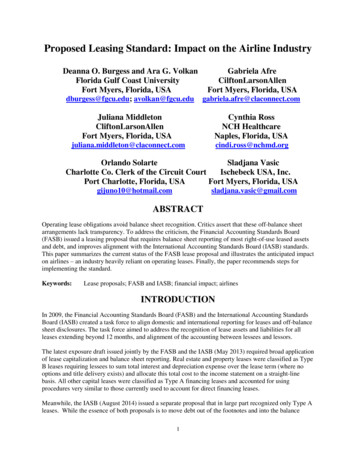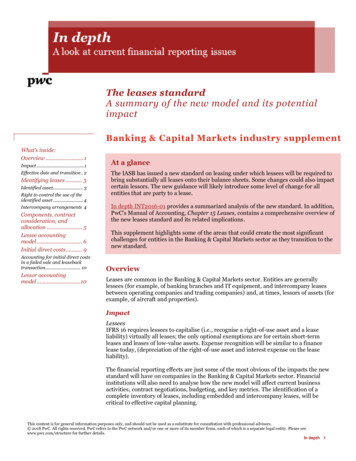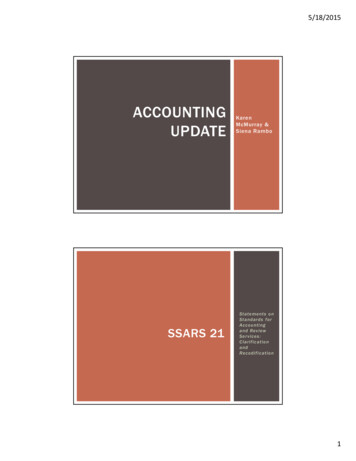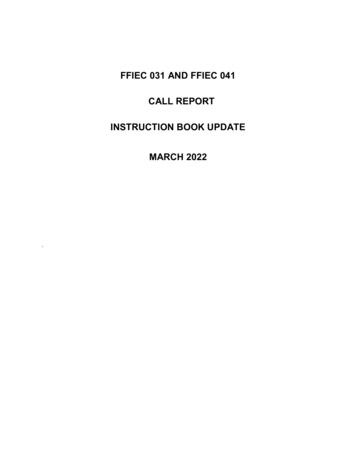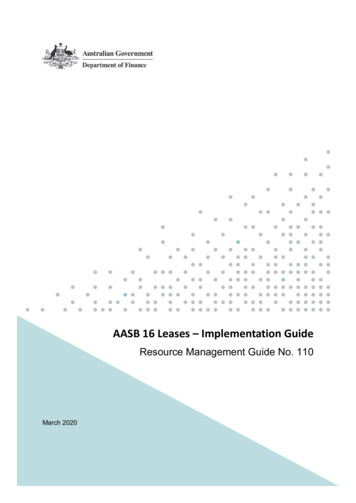
Transcription
AASB 16 Leases – Implementation GuideResource Management Guide No. 110March 2020
Department of FinanceRMG-110: AASB 16 Leases – Implementation Guide Commonwealth of Australia 2020ISBN: 978-1-925537-54-3 (Online or Print)With the exception of the Commonwealth Coat of Arms and where otherwise noted, allmaterial presented in this document is provided under a Creative Commons Attribution 3.0Australia (http://creativecommons.org/licenses/by/3.0/au) licence.The details of the relevant licence conditions are available on the Creative Commons website(accessible using the links provided) as is the full legal code for the CC BY 3 AU licence.Use of the Coat of ArmsThe terms under which the Coat of Arms can be used are detailed on the following act usPlease direct questions or comments about the guide to:Accounting and FrameworksFinancial Analysis, Reporting and ManagementDepartment of Finance1 Canberra AvenueForrest ACT 2603Email: accountingpolicy@finance.gov.auInternet: www.finance.gov.au2
Department of FinanceRMG-110: AASB 16 Leases – Implementation GuideContentsAASB 16 Leases – Implementation Guide1Audience5Key Points5Resources5Introduction6Part 1 – Identification of a Lease6Identification of a Lease6Separating lease components7Separating lease and non lease components7Short-term and low value exemptions8Intangible Assets9Part 2 – Lease Terms9Lease Terms9Part 3 – Right of Use Assets10Subsequent Measurement of Right of Use (ROU) Assets10Impairment of Right of Use Assets11Part 4 - Variable Lease Payments13Market Reviews during Lease Term13Part 5 - Lease Incentives14Fitout Incentives Received on Commencement Date14Fitout Incentives Received after Commencement Date14Part 6 - Discount Rates15Interest Rate Implicit in the Lease (IRI)15Incremental Borrowing Rate16Changes in Discount Rate16Lease Liability Interest Expense17Part 7 - Subleases17Classification of Subleases17Consolidation of Commonwealth Subleases183
Department of FinanceRMG-110: AASB 16 Leases – Implementation GuideMemorandums of Understanding18Part 8 – Make Good19Initial Recognition of Make Good Provisions19Changes to Make Good Provisions19Part 9 - Miscellaneous20Lease Portfolios20Net Cash Reconciliation Disclosure21Part 10 - Transition22Retrospective Application of AASB 1622Identification of Leases22ROU Assets Previously Accounted for as Operating Leases22Lease Incentive Provisions24Impairment on AASB 16 Transition24Appendices254
Department of FinanceRMG-110: AASB 16 Leases – Implementation GuideAudienceThis guide is relevant to Commonwealth officials responsible for the financial reporting oflease transactions.Key PointsThis guide assists Commonwealth entities with accounting for leases in accordance withAustralian Accounting Standard Board 16 Leases (AASB 16), applicable for the 2019-20 andfollowing financial years. The guide also provides a simple model to calculate leasebalances and example journals for common scenarios.ResourcesThis guide is available on the Department of Finance website at www.finance.gov.au.Other relevant publications include: AASB 16 Leases; AASB 2018-8 Amendments to Australian Accounting Standards – Right-of-UseAssets for Not-for-Profit Entities; AASB 137 Provisions, Contingent Liabilities and Contingent Assets; AASB 116 Property, Plant and Equipment; AASB 15 Revenue from Contracts with Customers; and Public Governance, Performance and Accountability (Financial Reporting) Rule2015 (FRR).5
Department of FinanceRMG-110: AASB 16 Leases – Implementation GuideIntroduction1.AASB 16 removes the distinction between operating and finance leases for lesseesand requires the recognition of a right-of-use (ROU) asset and lease liability on thebalance sheet for most leasing arrangements. AASB 16 is the Australian equivalent tothe International Accounting Standard Board’s (IASB’s) IFRS 16 Leases, which wasintroduced to address concerns regarding the lack of transparency relating to leaserights and obligations. AASB 16 is applicable for reporting periods commencing on orafter 1 January 2019.2.This guide summarises the Department of Finance’s (Finance’s) major policy decisionsregarding the application of AASB 16 and the main issues raised by Commonwealthentities. The guide aims to achieve consistency in accounting treatment of leasesamongst Commonwealth entities, which is necessary for the preparation of theConsolidated Financial Statements.3.Application of all requirements is subject to the principles of materiality. Entities shoulddocument all assessments made in implementing the standard.Part 1 – Identification of a LeaseIdentification of a Lease4.Paragraph 9 of AASB 16 states: “A contract is, or contains, a lease if the contractconveys the right to control the use of an identified asset for a period of time inexchange for consideration”. The customer would only have the right to control the useof an identified asset where they have:(a) the right to obtain substantially all of the economic benefits from use of theidentified asset; and(b) the right to direct the use of the identified asset 1.5.An identified asset is typically identified by being explicitly specified in a contract 2.However, even if an asset is specified, a customer does not have the right to use anidentified asset if the supplier has the substantive right to substitute the assetthroughout the period 3. This would only occur if the supplier has the practical ability tosubstitute alternative assets and could benefit economically from substituting the assetthroughout the period of use. A capacity portion of an asset would only be an identifiedasset if it is physically distinct 4.6.Paragraphs 9-17 and B9–B31 of AASB 16 provide more guidance on whether acontract is, or contains, a lease. IFRS 16 Illustrative Examples 1 – 10 alsocover identification of lease arrangements (available /IFRS16 IE 01-16.pdf)AASB 16(B9)AASB 16(B13)3AASB 16(B14)4AASB 16(B20)126
Department of FinanceRMG-110: AASB 16 Leases – Implementation GuideContracts will only contain a lease if the contract:(a) conveys the right to control the use of an identified asset for a period of time; and(b) requires an exchange of consideration.Separating lease components7.Paragraph B32 of AASB 16 states: “The right to use an underlying asset is a separatelease component if both:(a) the lessee can benefit from use of the underlying asset either on its own ortogether with other resources that are readily available to the lessee. Readilyavailable resources are goods or services that are sold or leased separately (by thelessor or other suppliers) or resources that the lessee has already obtained (from thelessor or from other transactions or events); and(b) the underlying asset is neither highly dependent on, nor highly interrelated with,the other underlying assets in the contract. For example, the fact that a lessee coulddecide not to lease the underlying asset without significantly affecting its rights to useother underlying assets in the contract might indicate that the underlying asset is nothighly dependent on, or highly interrelated with, those other underlying assets”.8.Entities may have a contract with separate lease components only where theunderlying assets are not closely related. For example, multiple floors in a leasedbuilding would normally be considered related given it is important the entity’s staff areco-located. Therefore, the floors leased should usually be accounted for as a singlelease rather than as separate lease components.9.Paragraphs 12-16 and B32–B33 provide more guidance on separating leasecomponents within a contract.Contracts would only contain separate lease components where the underlying assetsare not closely related.Separating lease and non lease components10.Where contracts contain a lease, entities are required to account for each leasecomponent within the contract separately from any non lease components, unless thepractical expedient in AASB 16(15) is applied 5. Contract consideration should beallocated based on the stand alone prices of the lease and non lease components.Non lease components should be accounted for under relevant standards.11.Paragraph 15 of AASB 16 states “As a practical expedient, a lessee may elect, byclass of underlying asset, not to separate non lease components from lease5AASB 16(12)7
Department of FinanceRMG-110: AASB 16 Leases – Implementation Guidecomponents, and instead account for each lease component and any associated nonlease components as a single lease component.”12.Commonwealth entities may only apply the single lease practical expedient when thenon-lease component is assessed to be immaterial to the lease. This is to ensure thatat a whole of government level, the recognition of non-lease components does notsignificantly alter lease measurement and associated expenses.13.Paragraphs 9-16 and B9–B33 of AASB 16 provide more guidance on separating leaseand non lease components within a contract.The single lease practical expedient, which combines the lease component and thenon lease component, should only be used by Commonwealth lessees when thenon-lease component is considered immaterial to the lease.Short-term and low value exemptions14.A lessee may elect not to comply with AASB 16 lease recognition requirements for:(a) short-term leases (i.e. a lease that has a lease term of 12 months or less at thecommencement date); or(b) leases for which the underlying asset is of low value. 615.Instead, the lessee would recognise the lease payments associated with those leasesas an expense on either a straight-line basis over the lease term or another systematicbasis. 7 The election for the short-term lease exemption must be made based by classof ROU asset. The election for ‘low value’ leases can be made on a lease-by leasebasis. 816.Low value is based on the value of individual assets when new. It is an absoluteconcept not related to an entity’s materiality threshold. Finance has determined a lowvalue of AUD 10,000 per asset, consistent with the IFRS 16 Basis for Conclusions.17.These exemptions will reduce the administrative burden from implementing AASB 16.AASB 16 contains guidance on low value assets in paragraphs B3-B8.Entities are required to apply the ‘short-term’ or ‘low value’ exemption in accordancewith AASB 16. Low value will be assets of AUD 10,000 or less.AASB 16, paragraph 5AASB 16, paragraph 68AASB 16, paragraph 8678
Department of FinanceRMG-110: AASB 16 Leases – Implementation GuideIntangible Assets18.Lessees may elect not to apply AASB 16 to intangible assets 9. To facilitate AASB 16implementation, entities are required to select this application option.Commonwealth lessees are required to not apply AASB 16 to intangible assets.Part 2 – Lease TermsLease Terms19.Lease terms are defined in Appendix A of AASB 16 as “The non-cancellable period forwhich a lessee has the right to use an underlying asset, together with both:(a) periods covered by an option to extend the lease if the lessee is reasonably certainto exercise that option; and(b) periods covered by an option to terminate the lease if the lessee is reasonablycertain not to exercise that option.”20.AASB 16(B34) states that the lease term is “the period for which the contract isenforceable. A lease is no longer enforceable when the lessee and the lessor each hasthe right to terminate the lease without the permission from the other party with nomore than an insignificant penalty.”21.Indicators that an option to extend may be ‘reasonably certain’ of being exercised or anoption to terminate the lease is reasonably certain not to be exercised, include: a clear ongoing operational requirement for the underlying assets capability a lack of suitable alternative assets at similar price significant costs for alternative arrangements (e.g. negotiation costs, relocation orintegration costs) significant leasehold improvements undertaken over the term of the lease; and precedent from previous practice.22.After the commencement date, a lessee should reassess the lease term after asignificant event or change in circumstances within their control, which affects whetherthe lessee is reasonably certain to exercise an option to extend or not to exercise anoption to terminate. Re-measurement of lease liabilities from reassessment of leaseterms should use a revised discount rate 10.23.Determining lease terms are considered in paragraphs 18 to 21 and B34 to B41 ofAASB 16.9AASB 16 paragraph 4AASB 16(40).109
Department of FinanceRMG-110: AASB 16 Leases – Implementation GuideLease terms are:(a) the non-cancellable period of the lease;(b) periods covered by an option to extend the lease if the lessee is reasonably certainto exercise that option; and(c) periods covered by an option to terminate the lease if the lessee is reasonablycertain not to exercise that option.Part 3 – Right of Use AssetsSubsequent Measurement of Right of Use (ROU) Assets24.Paragraphs 29 and 35 of AASB 16 require lessees to measure ROU assets at cost,unless the revaluation model is applied to ROU assets relating to a class of property,plant and equipment (PPE) measured at fair value under AASB 116 Property, Plant &Equipment 11.25.Paragraph 37 of AASB 116 defines a class of PPE assets as “A class of property, plantand equipment is a grouping of assets of a similar nature and use in an entity’soperations. The following are examples of separate classes: (a) land; (b) land andbuildings; (c) machinery; (d) ships; (e) aircraft; (f) motor vehicles; (g) furniture andfixtures; (h) office equipment; and (i) bearer plants”.26.The rights and obligations and risks and benefits of assets under lease contracts maydiffer substantially from corresponding assets owned outright. Lease ROU assets aretherefore a distinct ‘grouping of assets of a similar nature’ to corresponding assetsowned outright and will be separately disclosed in Commonwealth entity financialstatements.27.Lease ROU assets can therefore be classified by Commonwealth lessees as separateasset classes to corresponding assets owned outright. Because ROU assets areseparate asset classes and do not relate to a class of PPE to which Commonwealthentities already apply the revaluation model, ROU assets should be measured at costunder paragraph 35 of AASB 16.28.‘Peppercorn’ leases are those lease arrangements that are agreed for a nominalmonetary amount to satisfy the requirements of creating a legal contract. UnderAASB 16, ‘peppercorn leases’ are defined as “leases that have significantly belowmarket terms and conditions principally to enable the entity to further its objectives 12”.Commonwealth lessees should measure any ‘peppercorn’ lease ROU assets at costrather than at fair value, consistent with other ROU assets.Paragraph 29 of AASB 116 allows measurement of PPE assets after initial recognition at cost or fair value, by class of PPEasset.12AASB 2018-8, Amendments to AASB 16, paragraph Aus25.11110
Department of FinanceRMG-110: AASB 16 Leases – Implementation GuideROU assets should be classified by Commonwealth lessees as separate asset classesto corresponding assets owned outright. ROU assets should continue to be measuredat cost (not revalued to fair value) after initial recognition in Commonwealth entityfinancial statements.Impairment of Right of Use Assets29.AASB 16 requires ROU assets held at cost to be measured after deductingaccumulated depreciation and any accumulated impairment losses 13. Lessees shouldapply AASB 136 Impairment of Assets to determine whether ROU assets held at costare impaired and to account for any impairment losses 14.30.AASB 136 requires that non-financial assets are assessed for impairment indicators atthe end of each reporting period. Where impairment indicators exist, the assetsrecoverable amount should be estimated 15. Where impairment losses have beenpreviously recognised, AASB 136(110) also requires entities to assess whether thereare indications that impairment previously recognised has decreased. If so, the assetsrecoverable amount should be re-estimated.31.Impairment indicators are discussed in paragraph 12 of AASB 136. Indicatorsapplicable to ROU assets include: cheaper alternatives to the leased space are available, due to either restructuresor other changes in operational requirements or unexpected changes in marketrental rates the leased space has become surplus; or market interest rates have increased significantly since lease commencement,which would cause a re-rating of the relevant Incremental Borrowing Rate (IBR).32.AASB 136 defines impairment losses as the amount by which the carrying value of anasset exceeds its recoverable amount. ‘Recoverable amount’ is defined as the higherof fair value less costs of disposal 16 and its value in use 17. ‘Value in use’ is defined as“the present value of the future cash flows expected to be derived from an asset orcash generating unit” 18. Paragraph Aus5.1 of AASB 136 notes that recoverableamount will generally equal fair value determined under AASB 13 Fair ValueMeasurement for many assets of not for profit entities that are held for their continuingservice capacity rather than to generate net cash inflows.33.Fair value is defined as “the price that would be received to sell an asset or paid totransfer a liability in an orderly transaction between market participants at theParagraph 30 of AASB 16Paragraph 33 of AASB 1615Paragraph 9 of AASB 13616AASB 136(28) lists legal costs, stamp duty and other sale transaction fees as examples of costs of disposal.17Paragraph 6 of AASB 13618Paragraph 6 of AASB 136131411
Department of FinanceRMG-110: AASB 16 Leases – Implementation Guidemeasurement date” 19. AASB 136(53A) and AASB 13(2) notes that fair value is amarket based rather than an entity specific measurement.34.The recoverable amount of ROU assets will need to be estimated where impairmentindicators exist. However, ROU asset carrying balances should generally alreadyapproximate fair value where: the lease recently commenced and was negotiated on commercial terms a market rent review was recently undertaken the rent escalation factors applied under the lease contract closely reflectsestimated changes in market rates since lease commencement; or the lease term is near completion, at which time the fair value and the carryingvalue of the ROU asset will both be nil.35.Property indices may be available in some cases to estimate changes in market rentalrates. Entities can liaise with their Portfolio Department to see if a relevant property indexis available. Where the property is specialised and has unique attributes which wouldnot be incorporated in a general index, separate management estimates or externalvaluations may be required.36.Entities should also apply their estimated IBR as at the time of their recoverable amountcalculation. AASB 136 requires the discount rate when estimating the value in use to bea pre-tax rate that reflects current market assessments of: (a) the time value of money;and (b) the risks specific to the asset for which the future cash flow estimates have notbeen adjusted. Appendix A of AASB 136 provides additional guidance on estimating thediscount rate when an asset-specific market rate is not directly available. Appendix Aallows the entity’s IBR to be used as an estimate of the discount rate in this case.37.Surplus lease space should generally be accounted for under AASB 136 rather thanAASB 137 Provisions, Contingent Liabilities and Contingent Assets. Paragraph 5 ofAASB 137 states that when another standard deals with a specific type of provision,entities should apply that standard instead of AASB 137. Paragraph 69 of AASB 137states “Before a separate provision for an onerous contract is established, an entityrecognises any impairment loss that has occurred on assets dedicated to that contract(see AASB 136)”. Impairment for surplus lease space should not be recognised wherethe lease space is currently surplus but it is likely that the entity will be able to either usethe space or sublet it at a similar rent to the head lease soon.38.AASB 137 will still be applicable to lease contracts where an ROU asset has not beenrecognised, such as lease contracts that become onerous before commencement dateor onerous short term or low value leases. AASB 137 defines onerous contracts as “acontract in which the unavoidable costs of meeting the obligations under the contractexceed the economic benefits expected to be received under it. The unavoidable costsunder a contract reflect the least net cost of exiting from the contract, which is the lowerof the cost of fulfilling it and any compensation or penalties arising from failure to fulfil it.”19Paragraph 6 of AASB 136 and paragraph 9 of AASB 13. Although paragraph 6(b) of AASB 13 states that its measurementand disclosure requirements do not apply to lease transactions under AASB 16 Leases, its principles are still relevant.12
Department of FinanceRMG-110: AASB 16 Leases – Implementation GuideROU assets with indicators of impairment should have their recoverable amountestimated under AASB 136. ROU asset balances should generally approximate fairvalues where the lease recently commenced and was negotiated on commercial terms,was recently subject to a market rent review, the rent escalation factors applied to dateunder the lease contract approximate estimated changes in market rates since leasecommencement or the lease term has almost expired.Part 4 - Variable Lease PaymentsMarket Reviews during Lease Term39.Some leases have fixed annual increases over the lease term with one or moreintervening market reviews. Market reviews are variable lease payments underAASB 16, which are defined in AASB 16 Appendix A as: “The portion of paymentsmade by a lessee to a lessor for the right to use an underlying asset during the leaseterm that varies because of changes in facts or circumstances occurring after thecommencement date, other than the passage of time”. Paragraph 28 of AASB 16states “variable lease payments that depend on an index or a rate described inparagraph 27(b) include, for example, payments linked to a consumer price index,payments linked to a benchmark interest rate (such as LIBOR) or payments that vary toreflect changes in market rental rates”.40.Paragraph 27(b) of AASB 16 states that lease liabilities should initially be measuredincorporating variable lease payments at the rate applicable at commencement date.Future changes to variable lease payments linked to an index such as CPI should notbe estimated at lease commencement.41.Paragraphs 36(c) and 42(b) of AASB 16 states that lease liabilities should beremeasured to reflect revised lease payments due to a change in index or rate onlywhen the lease payments have changed, using the same discount rate 20. This mayrequire re-measurement of the lease liability each year as the index changes.Paragraph B42 of AASB 16 states that where there are more than one set of leasepayments under a lease agreement that a lessee could realistically be required tomake, the lessee should use the lowest realistically possible lease payments inmeasuring the lease liability.Commonwealth entities should incorporate all fixed annual rate changes, both beforeand after market review dates, in the initial measurement of the lease liability. Marketreview lease payment adjustments should not be incorporated in the measurement oflease liabilities until they become effective.20AASB 16, paragraphs 42,43.13
Department of FinanceRMG-110: AASB 16 Leases – Implementation GuidePart 5 - Lease IncentivesFitout Incentives Received on Commencement Date42.Lease incentives are defined in Appendix A of AASB 16 as: “Payments made by alessor to a lessee associated with a lease, or the reimbursement or assumption by alessor of costs of a lessee”.43.Paragraph 23 of AASB 16 states that lessees shall initially measure right-of-use assetsat cost. Paragraph 24 of AASB 16 states that:“The cost of the right-of-use asset shall comprise:(a) the amount of the initial measurement of the lease liability, as described inparagraph 26;(b) any lease payments made at or before the commencement date, less any leaseincentives received;”44.Fitout expenditure undertaken or reimbursed by the lessor may be recognised as anasset by either the lessee or lessor, depending on which party controls the economicbenefits from the expenditure. The expenditure may also have been promised by thelessor as an inducement for the lessee to enter the lease, or may have beenundertaken by the lessor independent of the lease contract.Lessor reimbursements of lessee leasehold improvement expenditure, or direct lessorexpenditure on leasehold improvements, should only be considered lease incentivesunder AASB 16, where:a)the expenditure was promised in the lease contract as a condition for the lessee toenter the lease; andb)the lessee rather than lessor primarily benefits from that expenditure and hasconsequently recognised the expenditure as a fitout asset.These incentives received should be deducted from the ROU asset’s initial value,consistent with paragraph 24(b) of AASB 16.Fitout Incentives Received after Commencement Date45.Lessors may promise to provide fitout or to reimburse lessee fitout costs as anincentive for lessees to enter a lease, but the incentive remains outstanding at leasecommencement. Lessee accounting for fitout incentives which remain outstanding atlease commencement differs from fitout incentives received on lease commencement(as outlined above).46.Paragraph 27 of AASB 16 states: “At the commencement date, the lease paymentsincluded in the measurement of the lease liability comprise the following payments forthe right to use the underlying asset during the lease term that are not paid at thecommencement date:14
Department of FinanceRMG-110: AASB 16 Leases – Implementation Guide(a) fixed payments (including in-substance fixed payments as described inparagraph B42), less any lease incentives receivable”.Therefore, fitout incentives which remain receivable at lease commencement need tobe offset against gross lease payments outstanding in calculating the initial leaseliability.47.Lessee accounting for fitout incentives receivable should reflect the substance of thearrangement and should not differ based on whether the lessee purchases the fitoutand is subsequently reimbursed by the lessor or the lessor purchases the fitout directlyon the lessee’s behalf. Where the lessee purchases the fitout and is subsequently reimbursed, thelessee should recognise a fitout asset when purchased and a correspondingincrease in the lease liability when the lessor reimbursement is received. Where the lessor purchases fitout directly and the lessee recognises that fitoutas their controlled asset, the lessee should also recognise a fitout asset and acorresponding increase in the lease liability.Fitout contribution incentives which remain receivable to the lessee on leasecommencement should be offset against gross lease payments outstanding incalculating the initial lease liability. The incentive should be recognised as an increasein the lease liability when received.Part 6 - Discount RatesInterest Rate Implicit in the Lease (IRI)48.For leases commencing on or after AASB 16 transition date, entities must adopt the‘interest rate implicit in the lease’ (IRI) to discount lease payments where it is readilyavailable 21. To determine the IRI, the lessee must know the lessor’s initial direct costsin establishing the lease and the unguaranteed residual value of the leased asset at theend of the lease 22. This information is often not available to the lessee.49.Lessees should identify whether this information is included in the lease contract. If it isnot, then lessees should apply their IBR in measuring the lease liability 23.Lessees should use the applicable IBR where the IRI cannot be readily determined.AASB 16(26)AASB 16, Appendix A.23AASB 16, paragraph 26.212215
Department of FinanceRMG-110: AASB 16 Leases – Implementation GuideIncremental Borrowing Rate50.A lessee’s IBR is “the rate of interest that a lessee would have to pay to borrow over asimilar term, with a similar security, the funds necessary to obtain an asset of a similarvalue to the right-of-use asset in a similar economic environment” 24.51.Non-borrowing Commonwealth entities should use the Australian Government’s IBRparameters. These zero coupon bond parameters are issued quarterly by theDepartment of Finance at nwealth-entities. Entities should refer tothe quarterly parameters that precede the lease commencement date (eg. leasescommencing between 1 October 2019 and 31 December 2019 should refer to the 30September quarter IBR parameters).52.Finance developed a Simple Lease Model (SLM) which calculates monthly leasebalances and includes an Excel ‘Goalseek’ function to calculate the IBR for each leasebased on the relevant quarterly zero coupon bond parameters. See Attachment B forthe SLM.53.Commonwealth corporate entities who can borrow to fund their activities should identifytheir own IBR.Non-borrowing Commonwealth entities should use the zero coupon bond yields on theFinance website to calculate their IBR. Commonwealth corporate entities who canborrow to fund their activities should identify their own IBR.Changes in Discount Rate54.Lessees should only re-measure lease liabilities using a revised discount rate wherethere is a change in the:(a) estimated lease term; or(b) a re-assessment of an option to purchase the underlying asset 25.55.Lessees should re-measure lease liabilities using an unchanged discount rate wherelease payments have changed due to an index or a market review or the estimatedresidual value guarantee amount payable has changed 26.Lessees should only re-measure lease liabilit
(a) short-term leases (i.e. a lease that has a lease term of 12 months or less at the commencement date); or (b) leases for which the underlying asset is of low value. 6 15. Instead, the lessee would recognise the lease payments associated with those leases as an expense on either a straight-line basis over the lease term or another systematic

